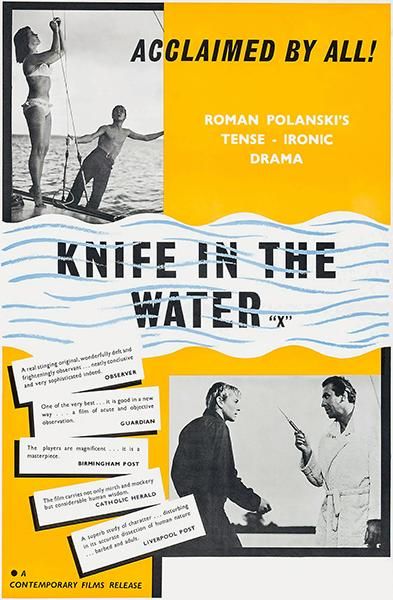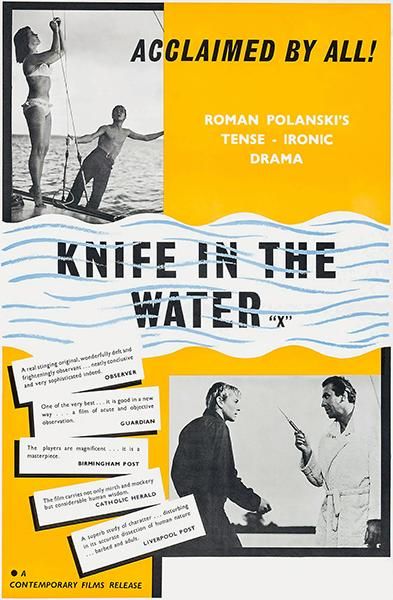
Apr 04, 2020 Written by naresh sharma Direction Tutorials


Understnding Knife in the water.
Though it was - Eight and half by Federico Fellini was the winner , but " knife in the water" directed by Roman Polanski was also nominated in 1963 for the category of "best foreign-language films" . The film has interesting opening sequence of the film and some important points to observe. I am attaching the link of the sequence above
Q.1. What are the 3-imp points need to be observed.
Q.2 among 3 important points one of them is very crtical.Do you think the screenplay writer would have written that in the screenplay and Direction just executed that. Or Director Interpreted the idea in his own way and then executed. How it was executed.
.................................
Point No 1: Till 1 mins, 55 sec, when the credit titles are over and Directed by Roman Polanksi comes as the last credit, the characters faces are covered under the shadow and highlights of the reflections of passing trees on the road and we don't know who they are .Only afterwards one gets to see clearly the faces of the couple and one notices a lady is driving the car .In the 50's and 1960’s ( as the film is black and white) , it was uncommon even in Europe in those days. Hiding the faces has 3 reasons.
a. To make the audience more curious about the characters inside .
b. Since they are not taking to each other just showing their faces would have been boring.
c. It is a visually poetic way of opening the film where you as an audience enjoy the high contrast black and white moving shadow and highlight of the leaves ( Orginal Print is really amazing to see ) falling on the windshield of the moving car so that confined fixed block of the windshield becomes more dynamic which otherwise dead space (There is a certain theory called Dynimzation of Space and Time).
Point No 2: It is a “Single Continuous Take” and the first cut come after 2 mins and 12 sec. The camera cut to outside back windshield glass of the car.Probably ,The reason of the long duration of the take is to indicates a long passage of time in a symbolic way which has resulted in a boring married life for the couple (which you comes to know later in the film) .
Point No 3: Background Music: The background music is slow and begins with the notes of the piano and then it merges with the saxophone.The music in the scene also enhanced the strained and cold relationship
Point no-4. As both of them are not taking to each other. It reflects the uneasiness in their relationship and a kind of tension between the two.
Point no-5 . Husband's Dominating Nature: The lady is driving the car properly and looks very confident and we feel she is at ease while driving. When she notices that a tank is blocking the half road .She slow down the car's speed ,as we hear the screech of the car's break. But without stopping the car , she smoothly moves the car towards the left of the road and quickly brings it back in the center of the road without showing any tension on her face . After this she is trying to bring the car's speed back to its normal speed the way it was earlier by changing the gear. On this the man gestures her by his hand as if he don't trust her driving skills and say something and we as an audience see the man and woman's mouths are moving for few seconds but we don't hear as it don't needs subtitles. When the man put his hand on the steering wheel she don't like it .As a reaction to it she stopped the car and without even saying a word, gets out and swaps the seat with him .
Point no-6. It is interesting to note the body language of the male actor . We feel that the man is dominating in nature and when takes the driving seat adjusting rear view mirror. He also taps both hand fingers when the lady stepped down the car
Point No 7: CRITICAL POINT: How in a single shot till 1min 55 sec one don’t clearly see the faces and without cutting the continous shot,one starts seeing the faces clearly even when the trees shadow are still falling on the glass. It is achieved through a filter called POLARISING FILTER, which cuts down the reflections of the glass( minimises it as the reflections are still there ) .Till 1.55 sec it is in off position in front of the lens. Till this point -1min 55 sec, it is as good as it is not there because it is not at the effective position and doing its job , the purpose it is used for. So you see more prominently the reflection of the leaves and after the last credit, assistant cameraman would have rotated the filter to its effective position while the shot is still going on and so one gets to faces clearly.
Point No 8:- It is equally important to note that how the camera is positioned so that you don’t see the reflections of camera and cameraman in the glass of windshield , even when the shot cut back to 2nd shot from backside through outside windshield and later frontal shot of the couple driving in 3rd shot,you don’t see the shadow of camera and cameraman.
Point No 9. Among various important points one of them is very critical.Do you think the screenplay writer would have written that in the screenplay and Director simply executed that? Or Director interpreted the idea in his own way and then executed. How it was executed?
Ans: This is a part of shot taking. Script writers are not expected to write technical details in the script. He may have simply written that - :- The film begins with a couple sitting in car and women driving while they are going out on weekend holiday.
It is a Director’s vision that how to make this otherwise dead shot an interesting. That's what we alsoa Director’s touch. What a great director can bring in to which can make a simple scene / shot looks great .